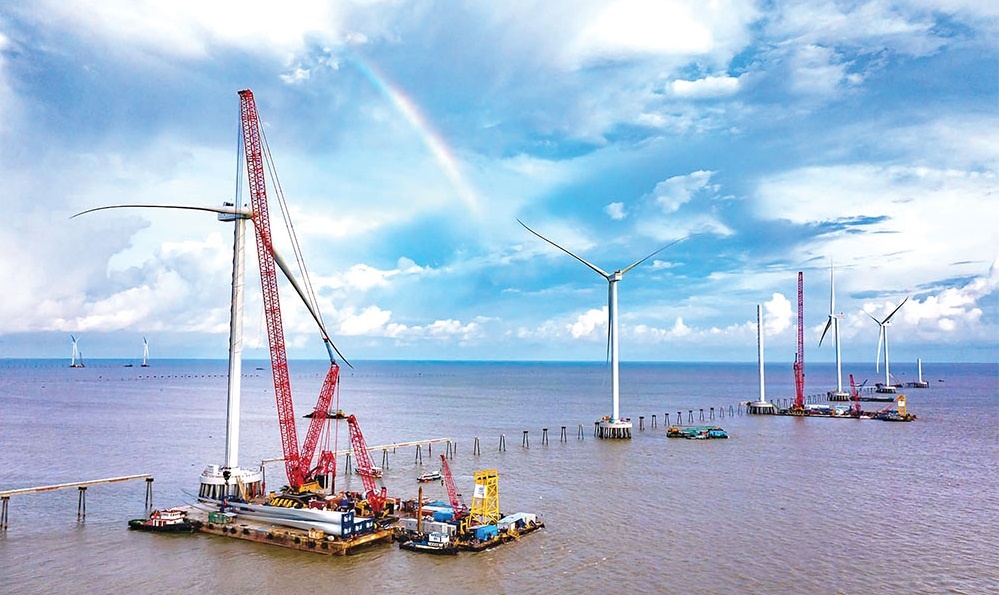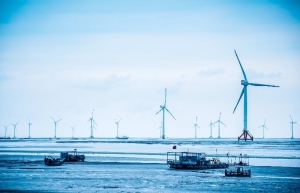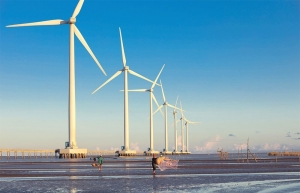Marine planning a prerequisite for offshore investment plans
A proposal from Electricity of Vietnam (EVN) to engage in 4,000MW of offshore wind power in the Gulf of Tonkin faces obstacles, according to Ngo Quoc Phuong, deputy director of EVN’s Investment Management Department.
“Some current regulations pertaining to offshore wind power are inadequate,” Phuong stated after reviewing relevant regulations, such as those pertaining to marine resources, the 2012 Marine Law, and the Law on Investment.
According to Phuong, the lack of identification of the authority responsible for authorising investment policies, and the dearth of regulations on the sequence of submission tracking dossiers, industry capacity, and unit pricing norms are causing issues for offshore wind projects.
According to the Danish Energy Agency, the Gulf of Tonkin region has a technical potential of approximately 18GW.
 |
| Marine planning a prerequisite for offshore investment plans, illustration photo/ Photo Le Toan |
In Vietnam, the largest barriers to offshore wind energy investment are legislative and technical. According to Phuong, the Power Development Plan VIII (PDP8) includes alternatives for onshore connections. Due to the ongoing construction of the marine spatial plan for 2021-2030, the distribution of zones and connection of lines on the sea do not have a specific plan for each location at this time.
The May release of PDP8 paved the way for the realisation of the 6GW target by 2030, thereby contributing to the 2050 objective of achieving net-zero emissions. But Phuong worries that this objective may be “unachievable” if Vietnam proceeds to delay the development and promulgation of the marine spatial plan and the completion of the offshore wind power infrastructure and legal system.
Depending on project scope, technology type, and sea and coastal resources, the offshore wind energy investment rate is decreasing swiftly. According to estimates by EVN Power Engineering Consulting 1, the total investment for a 1,000MW offshore wind power project in Vietnam is around $3.15 billion and is expected to decrease to $2.15 billion by 2030.
Wind energy developers from Europe believe Vietnam must surmount various obstacles in order to establish its offshore wind industry.
“The development of explicit policies and objectives will allow for long-term investment, thus lowering the cost of generating electricity from offshore wind,” said Neil Douglas, director of BVG Associates, a Danish firm assisting the Ministry of Industry and Trade with implementation of marine spatial planning. “This additionally assists in minimising risks and drawing low-cost loans for venture developers, thereby facilitating the execution of financially viable projects.”
Common obstacles to massive initiatives include permission at the state and local levels, ambiguity about the time schedule, and the risk of postponements and alterations, according to Douglas.
“Issues pertaining to responsibility for grid connection, location, selecting technology, and consolidation of technical standards must be resolved,” he said.
Marine spatial planning will be considered by the National Assembly this year, noted Sven Ernedal, chief of the Vietnam Energy Partnership Group’s (VEPG) expert group in charge of offshore wind development.
“Investment in offshore wind power is strongly linked to marine spatial planning. Preparing the legal framework is challenging and takes time, but it is necessary to get ready for the financial commitment,” Ernedal said.
The VEPG maintains a forum for the exchange of offshore wind knowledge between Vietnam and foreign collaborators. Ernnedal stated that the task force conducts a meeting monthly to discuss offshore wind power research and related issues. “We want to pinpoint best practices and offer policy suggestions on key offshore wind growth concerns in Vietnam,” Ernedal added.
 | Vietnam’s offshore wind realm remains in a muddle The strategy for renewable energy development being in limbo is holding back offshore wind power prospects in Vietnam. |
 | Voices grow louder for energy plan approval Numerous organisations and investors are urging Vietnam to swiftly define policies to accelerate the deployment of 7GW of offshore wind energy by 2030. |
 | Vietnam needs to modify policies to foster offshore wind power According to Vietnam's new electricity strategy, the objective is to ensure the overall capacity of offshore wind power reaches 6 GW by 2030 and 7-9GW by 2050. This will assure energy safety as well as meet the rising needs of the whole nation, in pace with its socioeconomic development. |
What the stars mean:
★ Poor ★ ★ Promising ★★★ Good ★★★★ Very good ★★★★★ Exceptional
Related Contents
Latest News
More News
- CME Solar strengthens position in Vietnamese renewables (December 30, 2025 | 11:21)
- Self-care signals shift towards sustainable healthcare (December 30, 2025 | 10:12)
- GreenYellow marks five years of clean energy growth in Vietnam (December 26, 2025 | 15:51)
- TCP Group partner with VNUS to launch water conservation project (December 25, 2025 | 14:00)
- Heavy industries set for pilot greenhouse gas quotas (December 25, 2025 | 10:00)
- Swedfund invests in MSME growth and climate action in Vietnam (December 19, 2025 | 11:42)
- GreenYellow brings solar energy to light up remote schools in Tuyen Quang province (December 19, 2025 | 08:00)
- Charge+, Grab partner to develop EV charging network in Vietnam (December 18, 2025 | 17:11)
- Linking sci-tech and innovation to Vietnam’s net-zero future (December 18, 2025 | 14:31)
- Driving double-digit growth through green and circular transformation in Vietnam (December 17, 2025 | 09:00)

 Tag:
Tag:




















 Mobile Version
Mobile Version